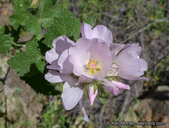Taxon Report
Malacothamnus lucianus (Kearney) K. MorseArroyo Seco bushmallow |
 © 2017 Keir Morse |
Taxon Summary
Malacothamnus lucianus, commonly known as Arroyo Seco bushmallow, is a perennial deciduous shrub in the Malvaceae that is found only in California. It occurs within Chaparral, Cismontane woodland, and Meadows and seeps, growing at elevations from 5 to 915 meters. Malacothamnus lucianus is ranked 1B.2, Plants Rare, Threatened or Endangered in California and Elsewhere; Moderately threatened in California.Classification
|
Scientific Name: |
Malacothamnus lucianus (Kearney) K. Morse |
|
Common Name: |
Arroyo Seco bushmallow |
| Family: | Malvaceae |
| Element Code: | PDMAL0Q0B2 |
| USDA Plants Symbol: | |
|
Synonyms/Other Names: |
|
Ecology and Life History
| Lifeform: | perennial deciduous shrub |
| Blooming Period: (Apr)May-Aug | (Apr)May-Aug |
| Elevation: | 5-915 (15-3000) |
| General Habitats: | Chaparral, Cismontane woodland, Meadows and seeps |
| Microhabitat: | |
| Microhabitat Details: |
Conservation Status
| CA Rare Plant Rank: | 1B.2 |
| Global Rank: | G1Q |
|
State Rank: |
S1 |
| State List: | None |
| Fed List: | None |
| Other Status: | BLM_S; SB_CalBG/RSABG; SB_SBBG; USFS_S |
|
CRPR Changes: |
|
Occurrence Data from the CNDDB
| Total Occurrences: | 9 |
| Element Occurrence Ranks: | |
| Excellent (A) | 0 |
| Good (B) | 3 |
| Fair (C) | 0 |
| Poor (D) | 2 |
| None (X) | 0 |
| Unknown (U) | 4 |
| California Endemic: True | |
| California Counties and Islands: Name (Code) | |
| Monterey (MNT) | |
| Quads: Name (Quad Code) | |
| Big Sur (3612137), Cone Peak (3612114), Junipero Serra Peak (3612124), Lopez Point (3612115), Partington Ridge (3612126) | |
Threat List Data from the CNDDB
| Threat List Total: | 6 | |
| EOs with Threat Listed: | Total EOs | % of EOs |
| 4 | 44 % | |
| Altered flood/tidal/hydrologic regime | 1 | 11% |
| Erosion/runoff | 1 | 11% |
| Grazing | 1 | 11% |
| Non-native plant impacts | 1 | 11% |
| Other | 1 | 11% |
| Road/trail construction/maint. | 1 | 11% |
Citation
California Native Plant Society, Rare Plant Program. 2025. Rare Plant Inventory (online edition, v9.5.1). Website https://www.rareplants.cnps.org [accessed 24 December 2025].